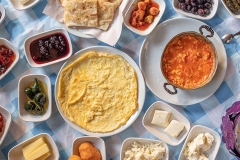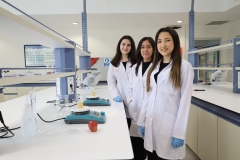
FACULTY OF ENGINEERING
Department of Food Engineering
MATH 240 | Course Introduction and Application Information
| Course Name |
Probability for Engineers
|
|
Code
|
Semester
|
Theory
(hour/week) |
Application/Lab
(hour/week) |
Local Credits
|
ECTS
|
|
MATH 240
|
Fall/Spring
|
3
|
0
|
3
|
6
|
| Prerequisites |
|
|||||||
| Course Language |
English
|
|||||||
| Course Type |
Elective
|
|||||||
| Course Level |
First Cycle
|
|||||||
| Mode of Delivery | - | |||||||
| Teaching Methods and Techniques of the Course | Lecture / Presentation | |||||||
| Course Coordinator | ||||||||
| Course Lecturer(s) | ||||||||
| Assistant(s) | ||||||||
| Course Objectives | This course aims to introduce students the theory of probability and its applications to engineering problems. |
| Learning Outcomes |
The students who succeeded in this course;
|
| Course Description | In this course some important theorems about probability are investigated. In addition, applications of random variables and their probability distributions are discussed. |
|
|
Core Courses | |
| Major Area Courses | ||
| Supportive Courses | ||
| Media and Management Skills Courses | ||
| Transferable Skill Courses |
WEEKLY SUBJECTS AND RELATED PREPARATION STUDIES
| Week | Subjects | Related Preparation |
| 1 | Sample space and events | Ronald E. Walpole, Raymond H. Myers, Sharon L. Myers, Keying Ye, “Probability”, Chap. 2 Probability & Statistics for Engineers and Scientists, 9th Edition (Pearson, 2017), 55-63. |
| 2 | Events and counting sample points | Ronald E. Walpole, Raymond H. Myers, Sharon L. Myers, Keying Ye, “Probability”, Chap. 2 Probability & Statistics for Engineers and Scientists, 9th Edition (Pearson, 2017), 58-71. |
| 3 | Counting sample points, probability of an event and additive rules | Ronald E. Walpole, Raymond H. Myers, Sharon L. Myers, Keying Ye, “Probability”, Chap. 2 Probability & Statistics for Engineers and Scientists, 9th Edition (Pearson, 2017), 64-79. |
| 4 | Additive rules, conditional probability of an event | Ronald E. Walpole, Raymond H. Myers, Sharon L. Myers, Keying Ye, “Probability”, Chap. 2 Probability & Statistics for Engineers and Scientists, 9th Edition (Pearson, 2017), 76-89. |
| 5 | Bayes’ rule | Ronald E. Walpole, Raymond H. Myers, Sharon L. Myers, Keying Ye, “Probability”, Chap. 2 Probability & Statistics for Engineers and Scientists, 9th Edition (Pearson, 2017), 92-97 |
| 6 | Concept of random variable and discrete probability distributions | Ronald E. Walpole, Raymond H. Myers, Sharon L. Myers, Keying Ye, “Random Variables and Probability Distributions”, Chap. 3 Probability & Statistics for Engineers and Scientists, 9th Edition (Pearson, 2017), 101-106. |
| 7 | Discrete probability distributions and continuous probability distributions | .Ronald E. Walpole, Raymond H. Myers, Sharon L. Myers, Keying Ye, “Random Variables and Probability Distributions”, Chap. 3 Probability & Statistics for Engineers and Scientists, 9th Edition (Pearson, 2017), 104-111. |
| 8 | Midterm | |
| 9 | Joint probability distributions | Ronald E. Walpole, Raymond H. Myers, Sharon L. Myers, Keying Ye, “Mathematical Expectation”, Chap. 4 Probability & Statistics for Engineers and Scientists, 9th Edition (Pearson, 2017), 114-124. |
| 10 | Mean and Variance of a Random variable | Ronald E. Walpole, Raymond H. Myers, Sharon L. Myers, Keying Ye, “Some Discrete Probability Distributions”, Chap. 5 Probability & Statistics for Engineers and Scientists, 9th Edition (Pearson, 2017), 131-147 |
| 11 | Binomial and multinomial distributions | Ronald E. Walpole, Raymond H. Myers, Sharon L. Myers, Keying Ye, “Some Discrete Probability Distributions”, Chap. 5 Probability & Statistics for Engineers and Scientists, 9th Edition (Pearson, 2017), 163-170.. |
| 12 | Binomial and multinomial distributions | Ronald E. Walpole, Raymond H. Myers, Sharon L. Myers, Keying Ye, “Some Discrete Probability Distributions”, Chap. 5 Probability & Statistics for Engineers and Scientists, 9th Edition (Pearson, 2017), 172-184. |
| 13 | Uniform, Normal, areas under the normal curve, applications of the normal dist. and exponential distribution | Ronald E. Walpole, Raymond H. Myers, Sharon L. Myers, Keying Ye, “Some Continuous Probability Distributions”, Chap. 6 Probability & Statistics for Engineers and Scientists, 9th Edition (Pearson, 2017), 191-205. |
| 14 | Uniform, normal, areas under the normal curve, applications of the normal dist. and exponential distribution | Ronald E. Walpole, Raymond H. Myers, Sharon L. Myers, Keying Ye, “Some Continuous Probability Distributions”, Chap. 6 Probability & Statistics for Engineers and Scientists, 9th Edition (Pearson, 2017), 191-205. |
| 15 | Semester review | |
| 16 | Final Exam |
| Course Notes/Textbooks | Ronald E. Walpole, Raymond H. Myers, Sharon L. Myers, Keying Ye, Probability and Statistics for Engineers and Scientists, 9th Edition (United States of America: Pearson, 2017). ISBN-13: 978-0134115856 |
| Suggested Readings/Materials | William Navidi, Statistics for Engineers and Scientists, 5th Ed. (Mc-Graw Hill, 2019) ISBN-13: 978-1260547887 |
EVALUATION SYSTEM
| Semester Activities | Number | Weigthing |
| Participation | ||
| Laboratory / Application | ||
| Field Work | ||
| Quizzes / Studio Critiques |
2
|
10
|
| Portfolio | ||
| Homework / Assignments | ||
| Presentation / Jury | ||
| Project | ||
| Seminar / Workshop | ||
| Oral Exams | ||
| Midterm |
1
|
40
|
| Final Exam |
1
|
50
|
| Total |
| Weighting of Semester Activities on the Final Grade |
3
|
50
|
| Weighting of End-of-Semester Activities on the Final Grade |
1
|
50
|
| Total |
ECTS / WORKLOAD TABLE
| Semester Activities | Number | Duration (Hours) | Workload |
|---|---|---|---|
| Theoretical Course Hours (Including exam week: 16 x total hours) |
16
|
3
|
48
|
| Laboratory / Application Hours (Including exam week: '.16.' x total hours) |
16
|
0
|
|
| Study Hours Out of Class |
14
|
3
|
42
|
| Field Work |
0
|
||
| Quizzes / Studio Critiques |
2
|
10
|
20
|
| Portfolio |
0
|
||
| Homework / Assignments |
0
|
||
| Presentation / Jury |
0
|
||
| Project |
0
|
||
| Seminar / Workshop |
0
|
||
| Oral Exam |
0
|
||
| Midterms |
1
|
30
|
30
|
| Final Exam |
1
|
40
|
40
|
| Total |
180
|
COURSE LEARNING OUTCOMES AND PROGRAM QUALIFICATIONS RELATIONSHIP
|
#
|
Program Competencies/Outcomes |
* Contribution Level
|
||||
|
1
|
2
|
3
|
4
|
5
|
||
| 1 | Being able to transfer knowledge and skills acquired in mathematics and science into engineering, | |||||
| 2 | Being able to identify and solve problem areas related to Food Engineering, | |||||
| 3 | Being able to design projects and production systems related to Food Engineering, gather data, analyze them and utilize their outcomes in practice, | |||||
| 4 | Having the necessary skills to develop and use novel technologies and equipment in the field of food engineering, |
|||||
| 5 | Being able to take part actively in team work, express his/her ideas freely, make efficient decisions as well as working individually, |
|||||
| 6 | Being able to follow universal developments and innovations, improve himself/herself continuously and have an awareness to enhance the quality, |
|||||
| 7 | Having professional and ethical awareness, |
|||||
| 8 | Being aware of universal issues such as environment, health, occupational safety in solving problems related to Food Engineering, | |||||
| 9 | Being able to apply entrepreneurship, innovativeness and sustainability in the profession, |
|||||
| 10 | Being able to use software programs in Food Engineering and have the necessary knowledge and skills to use information and communication technologies that may be encountered in practice (European Computer Driving License, Advanced Level), |
|||||
| 11 | Being able to gather information about food engineering and communicate with colleagues using a foreign language ("European Language Portfolio Global Scale", Level B1) |
|||||
| 12 | Being able to speak a second foreign language at intermediate level. |
|||||
| 13 | Being able to relate the knowledge accumulated during the history of humanity to the field of expertise |
|||||
*1 Lowest, 2 Low, 3 Average, 4 High, 5 Highest
NEWS |ALL NEWS

Online 'weight loss' period
The increase in time spent at home to protect against coronavirus and the habit of sedentary life caused a "weight" crisis for

The Aegean is distributing healing
The fear of catching coronavirus, which is transmitted to more than 73 million people worldwide, and the increase in flu cases with

Pandemic changed eating habits
The coronavirus, which negatively affected life in many issues from daily life to work and social interaction, also changed the eating habits

HIGH-SCHOOL STUDENTS EXPERIENCED COLLEGE IN FOOD ENGINEERING LABORATORIES
“SCIENCE DAYS” event was organized by Department of Food Engineering in Izmir University of Economics. This event aimed to teach science in

STUDENTS OF FOOD ENGINEERING DEPARTMENT DEVELOPED 'ATRICHOKE PASTE' FOR FIRST INTERNATIONAL URLA ARTICHOKE FESTIVAL
Most of the attenders enjoyed the 'Artichoke Paste', developed by the students of Food Engineering Department.

MAINTAINING HEALTHY EATING HABITS DURING HOLIDAY SEASON!
As the students got their report cards and started a long summer holiday, the experts pointed out the importance of not to


